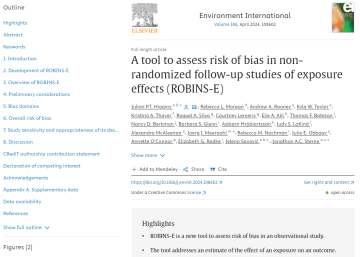ROBINS-E - a new tool for assessing risk of bias in observational studies
- 24 April 2024
A new tool for assessing risk of bias in observational studies of exposures provides a standardised framework for researchers to explore potential biases in cohort study results. The results of an international collaboration published in Environment International suggest the tool represents an important development in the integration of exposure assessment, evidence synthesis and causal inference.
The risk of bias in non-randomized follow-up studies of exposure effects (ROBINS-E) tool is mainly designed for researchers carrying out systematic reviews. A systematic review aims to identify and synthesise all the evidence available on a certain topic. It should include an assessment of the risk of bias of the studies included within it. A risk-of-bias assessment assesses the strength of evidence included in each study.
ROBINS-E lets researchers assess the potential effects of environmental, occupational and behavioural exposures on human health in observational studies. It provides a standardised framework to examine the range of biases that may affect the results of these studies. Important elements of the ROBINS-E tool include:
- A definition of the causal effect of interest
- Signalling questions to guide risk-of-bias judgements across seven domains
- Algorithms to suggest risk of bias judgements based on answers to signalling questions
- Overall risk-of-bias judgements based on the domain-specific assessments
Julian P T Higgins, Professor of Evidence Synthesis at Bristol Medical School and lead author, said:
“The ROBINS-E tool was developed through a collaboration between methodologists and stakeholders from fields such as environmental, occupational, chemical, clinical and public health. We hope that it will enable a thorough examination of the strength of evidence about the effect of an exposure on an outcome. However, we must also remember that evaluating risk of bias requires the review team to have a good understanding of both the subject matter and the different types of bias that may distort the results of observational studies.”
